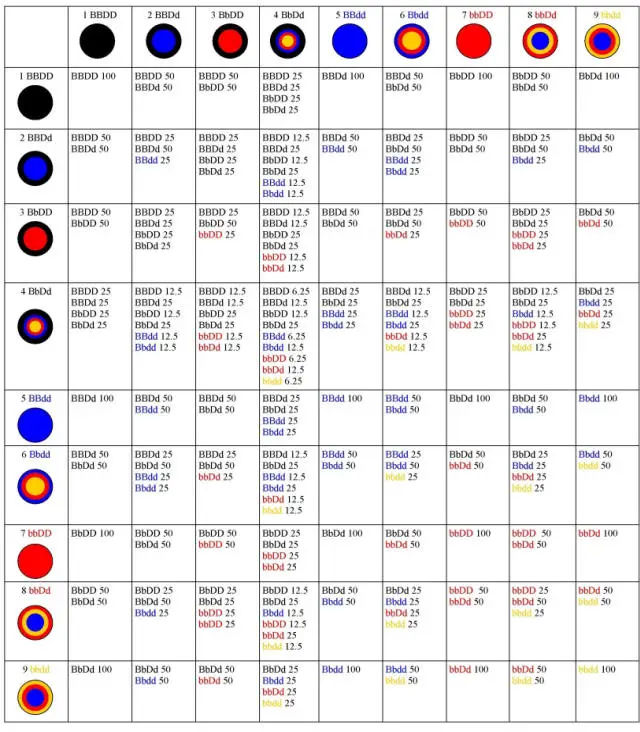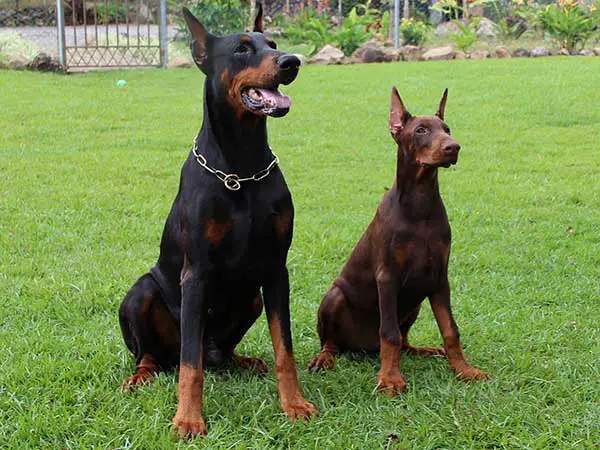There is a lot of debate regarding Doberman colors: which are the true color combinations, which should be accepted in show dogs and which colors should be avoided altogether?
Some dog owners believe that Dobermans are beautiful no matter their color and coat markings, while others stand by the rule that there are only four different colors of Dobermans that are acceptable.
What color do Dobermans come in and why does color matter so much to owners, breeders and associations?
Table of Contents
There are 5 recognized colors of dobermans – but not are considered equal
Color Inheritance In The DOBERMAN PINSCHER

Key to Chart colors
![]() = Black (with rust-colored markings)
= Black (with rust-colored markings)
![]() = Blue (actually gray, with rust markings)
= Blue (actually gray, with rust markings)
![]() = Red (various shades of red-brown with rust markings)
= Red (various shades of red-brown with rust markings)
![]() = Fawn (called “Isabella;” about the color range of ‘camel’s hair’ with rust markings)
= Fawn (called “Isabella;” about the color range of ‘camel’s hair’ with rust markings)
B is the factor for black; it is dominant over b, the red factor.
D is the ‘non dilution’ factor; it is dominant over the dilution factor, d.
The numbers (6.25 – 100) are percentages of each color type to be expected.
The black doberman:
Dobermans have two different genes for determining color – one for the black color and one for color dilution. In its most dominant form, this results in a BBDD sequence, at its weakest, this is seen as a bbdd.
When there is at least one dominant black gene and dilution gene, we get the familiar dog with the black coat and tan/rust markings on the face, chest and legs. These sequences are BBDD, BBDd, BbDD or BbDd.
The red Doberman:
There are times when the dog has at least one dominant dilution allele but but two recessive alleles – either bbDD or bbDd. This is when we see the red version of the Doberman rather than the black.
This name is a little misleading and confusing for some dog owners. Red is the accepted term for this rich, warm shade in America, but it is not red like the red hair of a human. Some owners refer to this coat type as chocolate because it s immediately more brown than red and brown is more commonly used in Europe.
The blue Doberman:
The opposite of this is where a dog has at least one dominant color allele and two recessive dilution alleles – BBdd or Bbdd. This where we see blue Doberman puppies in a litter.
Again, blue is the term that most breeders are used to when it comes to this sort of dilution and tone. Others may refer to these animals as a gray Doberman because of the charcoal or silver tones to the fur.
The fawn Doberman:
Finally there is the Doberman with a complete set of recessive alleles – bbdd. This is where the fawn, or Isabella, variant comes from.
These fawn and blue dogs are accepted by some associations because they are sill pure, characteristic Dobermans. However, there are some owners that warn against opting for dogs with these recessive alleles. There are reports from owners that these dogs can suffer more from ingrown hairs and staff infections because of the quality of the hair and the distribution of the pigments.
There are many Doberman Pinscher color variations out there, but not all of them are welcomed by all associations.
Black and red/brown dogs are generally accepted for dog shows with no concern because of the strength of the genes and gene pool. The status of these blue and fawn dogs can depend on the association because some can see past the recessive genes to the other breed characteristics and some can’t.
The biggest problem is seen with the white dogs.
The white Doberman:
The white dobie is seen as something of a rarity and a desirable oddity for some dog owners that don’t really care about breed standards. Others look down on this inbred dog because it does not class as an acceptable type of Doberman and there are health concerns.
This variant come about through inbreeding in the 1970s. A white dog was bred with her son, and the son with female siblings, to stabilize this odd mutation. In many ways these dogs are really more of a cream color with white markings and should not be mistaken for the albino dogs mentioned below.
There are some medical issues and pigmentation traits that can lead to other oddities in Doberman coat colors.
The albino Doberman:
The first thing to remember here is that an albino Doberman Pinscher is different from the white variant. This is not about a deliberate breeding of that pale cream coat and white markings but rather a medical problem.
This is where the most heated debate of all comes into play. There are breeders and associations that are deemed to be “prejudice” against white Dobies because they are tarred with the same brush as albino ones. Albinism is the result of a lack of pigment in the coat, which leads to a pale, poor quality fur and pale eyes.
This can cause photo-sensitivity and poor eyesight (which can then lead to behavioral issues and discomfort in public places) and well as skin sensitivity and associated disorders. White variants are less likely to have these problems, but the issue of inbreeding still stands.
The all black Doberman:
The melanistic Doberman Pinscher is the opposite end of the scale to the albino dog in more ways than one. This is where the pup has too much melanin pigmentation in their skin and fur and this results in a much darker coat. Again,
this is seen as an unwelcome trait, and these all-black dogs don’t meet association standards. However, they do not seem to receive the same negative treatment as white dogs. This could be due to two important factors: the lack of information about this rare mutation and the lack of health issues, especially compared to the albino dog.
Choosing the right Doberman color variations
The debate over Doberman colors is still strong and there is still a clear divide when it comes to the “true” colors of Dobermans against the diluted oddities.
Some prefer to stick with the strong dominant genes of a black and rust or red and rust and are completely against the idea of a white Doberman Pinscher.
Some accept that blue Doberman Pinschers are acceptable, but would recommend against them because of potential health issue.
Others are happy to have a Doberman of any color as long as it is a happy, healthy member of the family. If you are heading to a breeder and want a pedigree show puppy, stick with the accepted colors and avoid the “rare” melanistic or albino dogs. If you are getting a rescue dog, just be aware of the implications of getting a dog with an unusual coat color.
Featured Image: Pixabay
Resources:
Doberman Pinscher Club of America

